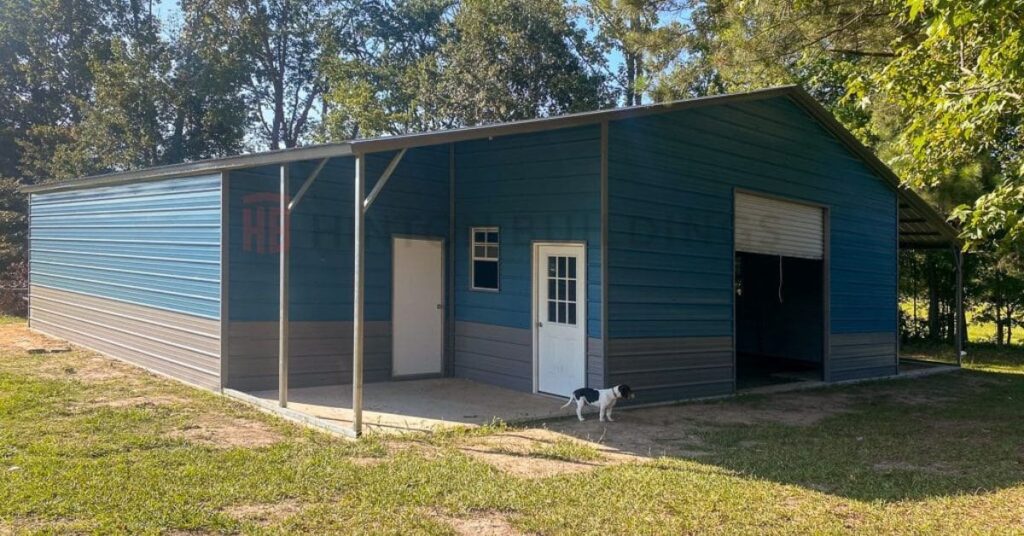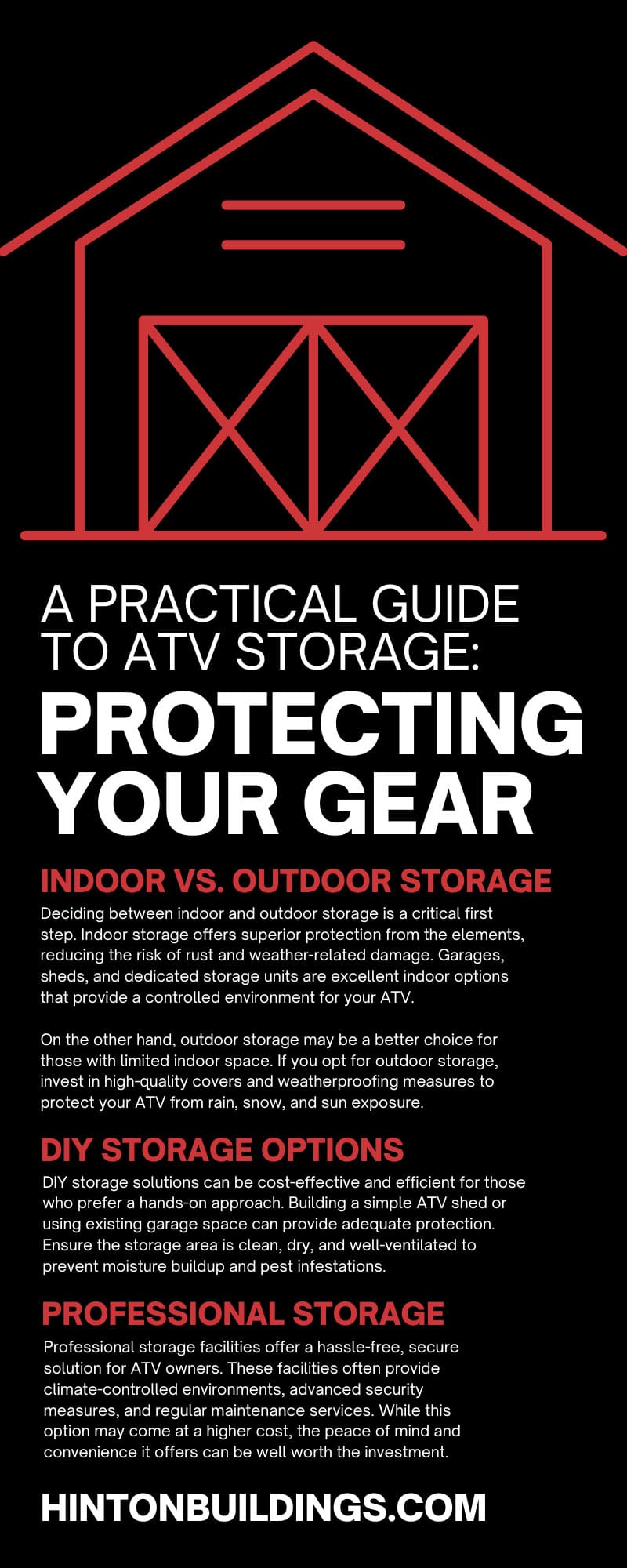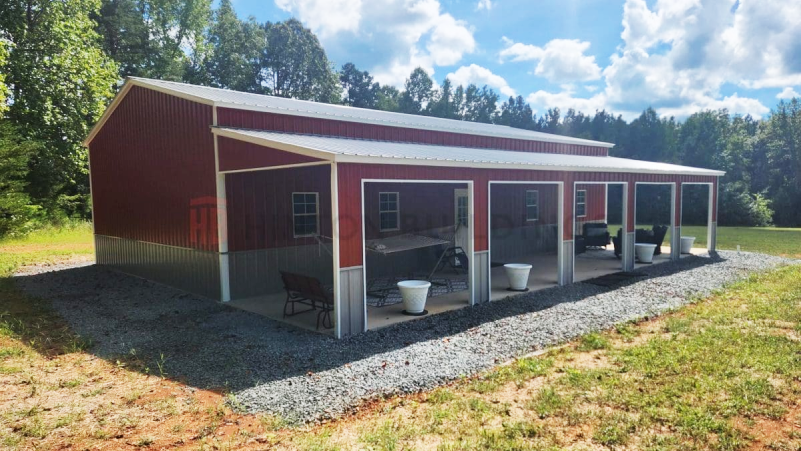
All-terrain vehicle (ATV) owners in constant search of adventure know the thrill of hitting the trails. But what happens when the ride is over? Proper ATV storage and care are essential to ensure your equipment stays in good condition and is ready for your next escapade. With this practical guide to ATV storage, you’ll have no problem protecting your gear while it’s not in use.
ATV riding has grown in popularity, drawing in a diverse mix of thrill-seekers, nature lovers, and weekend warriors. We can attribute this popularity growth to the adventurous experience of exploring rough terrains and the adrenaline rush that comes with it. An ATV offers unparalleled freedom and excitement, whether you’re navigating the sandy dunes, forest trails, or mountainous paths.
However, communicating proper maintenance and storage techniques becomes increasingly important as more people invest in ATVs. Neglecting these aspects can lead to costly repairs, reduced performance, and a shortened lifespan for your ATV.
Proper storage is crucial for maintaining your ATV’s performance and longevity. Exposure to harsh weather conditions, pests, and environmental contaminants can wreak havoc on your vehicle. Proper storage protects your investment and ensures your ATV is always ready for your next adventure.
Unattended ATVs can degrade, leading to issues such as rust, battery failure, and mechanical problems. Avoid these pitfalls and enjoy a reliable ride every time you hit the trails by taking the time to store your ATV correctly.
Deciding between indoor and outdoor storage is a critical first step. Indoor storage offers superior protection from the elements, reducing the risk of rust and weather-related damage. Garages, sheds, and dedicated storage units are excellent indoor options that provide a controlled environment for your ATV.
On the other hand, outdoor storage may be a better choice for those with limited indoor space. If you opt for outdoor storage, invest in high-quality covers and weatherproofing measures to protect your ATV from rain, snow, and sun exposure.
DIY storage solutions can be cost-effective and efficient for those who prefer a hands-on approach. Building a simple ATV shed or using existing garage space can provide adequate protection. Ensure the storage area is clean, dry, and well-ventilated to prevent moisture buildup and pest infestations.
Additionally, using sturdy tarps, wheel chocks, and protective covers can safeguard your ATV. Elevating the vehicle on blocks or stands can also prevent tire flat spots and reduce pressure on the suspension system.
Professional storage facilities offer a hassle-free, secure solution for ATV owners. These facilities often provide climate-controlled environments, advanced security measures, and regular maintenance services. While this option may come at a higher cost, the peace of mind and convenience it offers can be well worth the investment.
Consider factors such as location, reputation, and the services they offer when choosing a professional storage provider. Look for facilities specializing in ATV storage with a track record of satisfied customers.
Thoroughly clean and perform routine maintenance on your ATV before storing it. Wash off dirt, mud, and debris to prevent corrosion and damage. Pay special attention to the undercarriage, wheels, and engine components. A clean ATV looks better and reduces the risk of long-term damage.
Perform routine maintenance tasks such as changing the oil, lubricating moving parts, and checking fluid levels. Address any minor repairs or issues before storing the ATV to avoid complications down the road.
Protecting your ATV from the elements is crucial, whether you choose indoor or outdoor storage. Use high-quality covers specifically designed for ATVs to shield your vehicle from dust, moisture, and UV rays. Ensure the cover fits snugly and consists of durable, weather-resistant materials.
In addition to using a cover, consider applying a rust inhibitor or protective coating to metal components. This extra layer of defense can prevent rust and corrosion, especially during long-term storage.
Proper fuel and battery management are vital for long-term ATV storage. Add a fuel stabilizer to the gas tank to prevent the fuel from breaking down and causing engine issues. Run the engine for a few minutes to circulate the stabilizer throughout the system.
Disconnect the battery and store it in a cool, dry place. Regularly check the battery’s charge and use a trickle charger if necessary to maintain its health. These simple steps can prevent starting problems and extend your battery’s life.
Periodic checkups are essential even when your ATV is in storage. Inspect the vehicle every few months to ensure everything is in order. Check for signs of moisture, pests, and any potential issues that may arise.
Start the engine occasionally to keep the internal components lubricated and in good working condition. Regular checkups can help you catch problems early and maintain your ATV’s readiness for action.
Keep your ATV’s insurance and registration up to date, even during periods of inactivity. Doing so ensures your vehicle is legally compliant and protected against potential risks such as theft or damage. Review your insurance policy to understand the coverage for stored vehicles and make any necessary adjustments.
Informing your insurance provider about the storage arrangements can also help in case of any claims. Proper documentation and records will facilitate a smooth process if any issues arise.
Protecting your ATV from theft is a crucial aspect of storage. Use heavy-duty locks, chains, and security systems to deter potential thieves. Consider adding motion-sensor lights and security cameras to enhance your indoor storage facility’s efficacy.
Registering your ATV with a national database can also aid in recovery if someone steals it. Marking components with unique identifiers and keeping detailed records of the vehicle’s specifications can assist law enforcement in locating and returning your ATV.
Protect your gear at all costs with this practical guide to ATV storage and ensure you’re properly investing in your vehicle’s longevity and performance. By taking these necessary steps, you can ensure your ATV is always ready for an adventure. Well-stored ATVs retain their value better, making them more attractive for resale if you decide to upgrade in the future.
Do you need a reliable location to store your ATV or other equipment? If you want the best barn builders, NC has to offer, Hinton Buildings has been in the business for over two decades. We’ll help you with everything, from design to construction, so you can keep your items safe and protected all year long.

